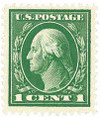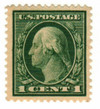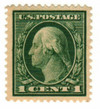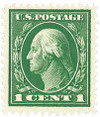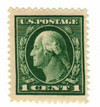
# 405 - 1912 1c Washington, green, single line watermark
Â
Series of 1912-14 1¢ Washington
Printed by: Bureau of Engraving and Printing
Method:Â Flat plate
Watermark: Â Single line
Perforation: 12
Color: Green
New York’s Evacuation Day
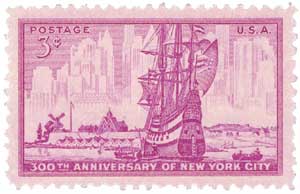
On November 25, 1783, the British Army left New York City following the American Revolutionary War. The date was observed for over a century as Evacuation Day, with celebrations rivaling those held on the Fourth of July.
After suffering high losses at the Battle of Long Island in August 1776, General George Washington and the Continental Army retreated across the East River to Manhattan Island. The British moved in and raised their flag over Fort George on September 15, 1776. Despite scoring a victory at the Battle of Harlem Heights, Washington’s troops were defeated at Fort Washington and Fort Lee and evacuated Manhattan Island in mid-November. The British held New York City for the rest of the war.
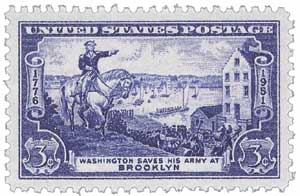
The Treaty of Paris was drafted in November 1782 and signed in September 1783, bringing an end to the war. In August 1783, in anticipation of the treaty’s signing, the British commander in charge of New York received orders to evacuate. He informed the Confederation Congress that he would begin the process, but that he couldn’t provide an exact date, as thousands of loyalist refugees were flooding the city to evacuate with them. Eventually, he announced they would evacuate the city at noon on November 25, 1783. Reportedly, one resident raised an American flag before noon, leading to a brief fight with a British officer.
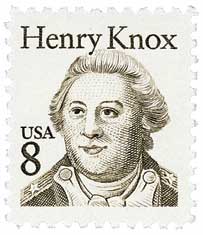
The British evacuated as promised and Henry Knox and his men moved in to secure the city. During this process, Knox’s troops removed British flags around town. The flag on the Battery at Fort George was nailed to the flagpole. And the British had greased the pole in an act of resistance. After several unsuccessful attempts to remove it, wooden cleats were nailed to the pole and a soldier climbed it and replaced the flag with the Stars and Stripes.

George Washington and New York General George Clinton then entered New York and reclaimed Fort Washington. They then led the Continental Army in a parade to the Battery and Fraunces Tavern. That evening, Washington, Clinton, and more than 120 guests celebrated with a public dinner. The night ended with 13 toasts to the US, France’s King Louis XVI (who’d supported the Americans in the war), the Netherlands, the king of Sweden, the Continental Army, France’s armies and fleets, the fallen soldiers, military children, justice, and “the Vindicators of the Rights of Mankind in every Quarter of the Globe.† They also drank to America becoming an asylum to all the persecuted on Earth, the states holding a close union to guard Liberty, and that “the Remembrance of THIS DAY be a Lesson to Princes.â€

Evacuation Day celebrations continued for over a week until George Washington departed New York on December 4. One year after Evacuation Day, New York celebrated the anniversary with the ringing of church bells and a flag raising at the Battery. In the years to come, Evacuation Day became one of the most important holidays in New York City, with its celebration of military heroes, fireworks, banquets, military drills, parades, and patriotic plays rivaling those held on the Fourth of July. There was even a greased pole climbing contest for boys, that echoed the attempts to remove the British flag on the first Evacuation Day.
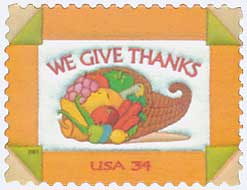
The holiday’s popularity began to decline in the mid-1800s with the Mexican-American War. Also around this time, Thanksgiving was often proclaimed by state governors, and was usually celebrated on Evacuation Day. Abraham Lincoln’s 1863 proclamation calling for Thanksgiving to be celebrated on the last Thursday of November overshadowed Evacuation Day. Evacuation Day celebrations continued for several more years and statues honoring George Washington, Nathan Hale, and Daniel Chester French were unveiled on that day. Evacuation Day was officially celebrated for the last time in 1916, with World War I and America’s alliance with Britain signaling the end of an era. Smaller commemorations were held over the years and a large one was staged in 2008 for the 225th anniversary. And in 2016, a street near the Bowling Green was renamed Evacuation Day Plaza.
Â
Â
Series of 1912-14 1¢ Washington
Printed by: Bureau of Engraving and Printing
Method:Â Flat plate
Watermark: Â Single line
Perforation: 12
Color: Green
New York’s Evacuation Day

On November 25, 1783, the British Army left New York City following the American Revolutionary War. The date was observed for over a century as Evacuation Day, with celebrations rivaling those held on the Fourth of July.
After suffering high losses at the Battle of Long Island in August 1776, General George Washington and the Continental Army retreated across the East River to Manhattan Island. The British moved in and raised their flag over Fort George on September 15, 1776. Despite scoring a victory at the Battle of Harlem Heights, Washington’s troops were defeated at Fort Washington and Fort Lee and evacuated Manhattan Island in mid-November. The British held New York City for the rest of the war.

The Treaty of Paris was drafted in November 1782 and signed in September 1783, bringing an end to the war. In August 1783, in anticipation of the treaty’s signing, the British commander in charge of New York received orders to evacuate. He informed the Confederation Congress that he would begin the process, but that he couldn’t provide an exact date, as thousands of loyalist refugees were flooding the city to evacuate with them. Eventually, he announced they would evacuate the city at noon on November 25, 1783. Reportedly, one resident raised an American flag before noon, leading to a brief fight with a British officer.

The British evacuated as promised and Henry Knox and his men moved in to secure the city. During this process, Knox’s troops removed British flags around town. The flag on the Battery at Fort George was nailed to the flagpole. And the British had greased the pole in an act of resistance. After several unsuccessful attempts to remove it, wooden cleats were nailed to the pole and a soldier climbed it and replaced the flag with the Stars and Stripes.

George Washington and New York General George Clinton then entered New York and reclaimed Fort Washington. They then led the Continental Army in a parade to the Battery and Fraunces Tavern. That evening, Washington, Clinton, and more than 120 guests celebrated with a public dinner. The night ended with 13 toasts to the US, France’s King Louis XVI (who’d supported the Americans in the war), the Netherlands, the king of Sweden, the Continental Army, France’s armies and fleets, the fallen soldiers, military children, justice, and “the Vindicators of the Rights of Mankind in every Quarter of the Globe.† They also drank to America becoming an asylum to all the persecuted on Earth, the states holding a close union to guard Liberty, and that “the Remembrance of THIS DAY be a Lesson to Princes.â€

Evacuation Day celebrations continued for over a week until George Washington departed New York on December 4. One year after Evacuation Day, New York celebrated the anniversary with the ringing of church bells and a flag raising at the Battery. In the years to come, Evacuation Day became one of the most important holidays in New York City, with its celebration of military heroes, fireworks, banquets, military drills, parades, and patriotic plays rivaling those held on the Fourth of July. There was even a greased pole climbing contest for boys, that echoed the attempts to remove the British flag on the first Evacuation Day.

The holiday’s popularity began to decline in the mid-1800s with the Mexican-American War. Also around this time, Thanksgiving was often proclaimed by state governors, and was usually celebrated on Evacuation Day. Abraham Lincoln’s 1863 proclamation calling for Thanksgiving to be celebrated on the last Thursday of November overshadowed Evacuation Day. Evacuation Day celebrations continued for several more years and statues honoring George Washington, Nathan Hale, and Daniel Chester French were unveiled on that day. Evacuation Day was officially celebrated for the last time in 1916, with World War I and America’s alliance with Britain signaling the end of an era. Smaller commemorations were held over the years and a large one was staged in 2008 for the 225th anniversary. And in 2016, a street near the Bowling Green was renamed Evacuation Day Plaza.
Â



